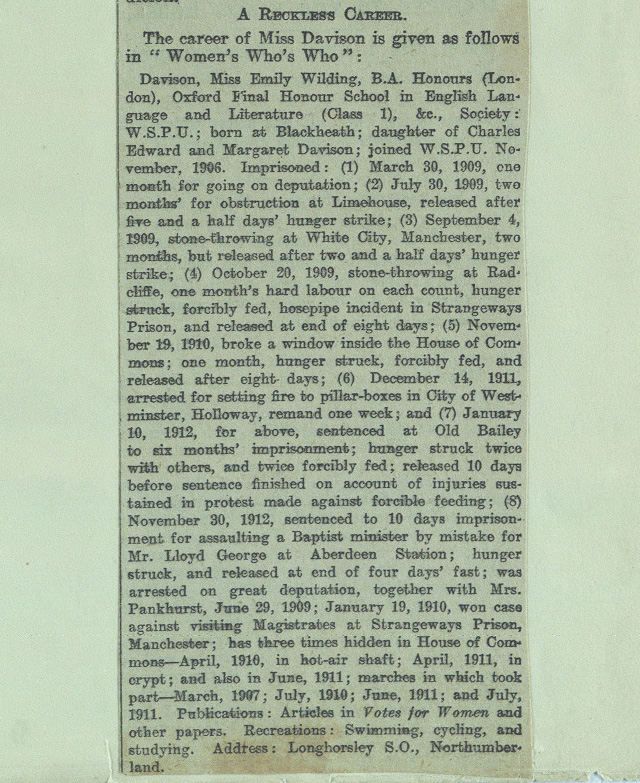
Extract 3 out of 3. Three extracts from an article called ‘Sensational Derby’ in The Morning Post, 5 June 1913, Catalogue ref: HO 144/1150/210696
The Derby is a horse race held each year at Epsom. Suffragist is a term used to describe someone who wants political voting rights given to more people, in this case to women.
Transcript
A RECKLESS CAREER
The career of Miss Davison is given as follows in “Women’s Who’s Who”:
Davison, Miss Emily Wilding, BA Honours (London), Oxford Final Honour School in English Language and Literature (Class I), &c., Society: W.S.P.U.; born at Blackheath; daughter of Charles Edward and Margaret Davison; joined W.S.P.U. November 1906.
Imprisoned: (1) March 30, 1909, one month for going on deputation;
(2) July 30, 1909, two months’ for obstruction [blocking] at Limehouse, released after five and a half days’ hunger strike;
(3) September 4, 1909, stone-throwing at White City, Manchester, two months, but released after two and a half days’ hunger strike;
(4) October 20, 1909, stone-throwing at Radcliffe, one month’s hard labour on each count, hunger struck, forcibly fed, hose-pipe incident in Strangeways prison and released at end of eight days;
(5) November 19, 1910, broke a window inside the House of Commons; one month, hunger struck, forcibly fed, and released after eight days;
(6) December 14, 1911, arrested for setting fire to pillar-boxes in City of Westminster; Holloway, remand one week; and
(7) January 10, 1912, for above, sentenced at Old Bailey to six months’ imprisonment; hunger struck twice with others, and twice forcibly fed; released 10 days before sentence finished on account of injuries sustained in protest made against forcible feeding;
(8) November 30, 1912, sentenced to 10 days imprisonment for assaulting a Baptist Minister by mistake for Mr. Lloyd George at Aberdeen Station; hunger struck, and released at end of 4 days’ fast; was arrested on great deputation, together with Mrs. Pankhurst, June 29, 1909; January 19, 1910, won case against visiting Magistrates at Strangeways Prison, Manchester; has three times hidden in House of Commons – April, 1910, in hot-air shaft; April, 1911, in crypt; and also in June, 1911; marches in which took part – March, 1907; July, 1910; June, 1911; and July, 1911.
Publications: Articles in ‘Votes for Women’ and other papers.
Recreations: Swimming, cycling and studying. Address: Longhorsley S.O., Northumberland.
- What happened on Derby day according this newspaper?
- What is the attitude of the newspaper towards Emily Davison? [Consider the headline, language and tone.]
- How did spectators of the race, as reported by the newspaper, explain events in Source 3b?
- In what ways had Emily Davison supported the Suffragette movement according to ‘Women’s Who’s Who’ extract in the article in Source 3c?
